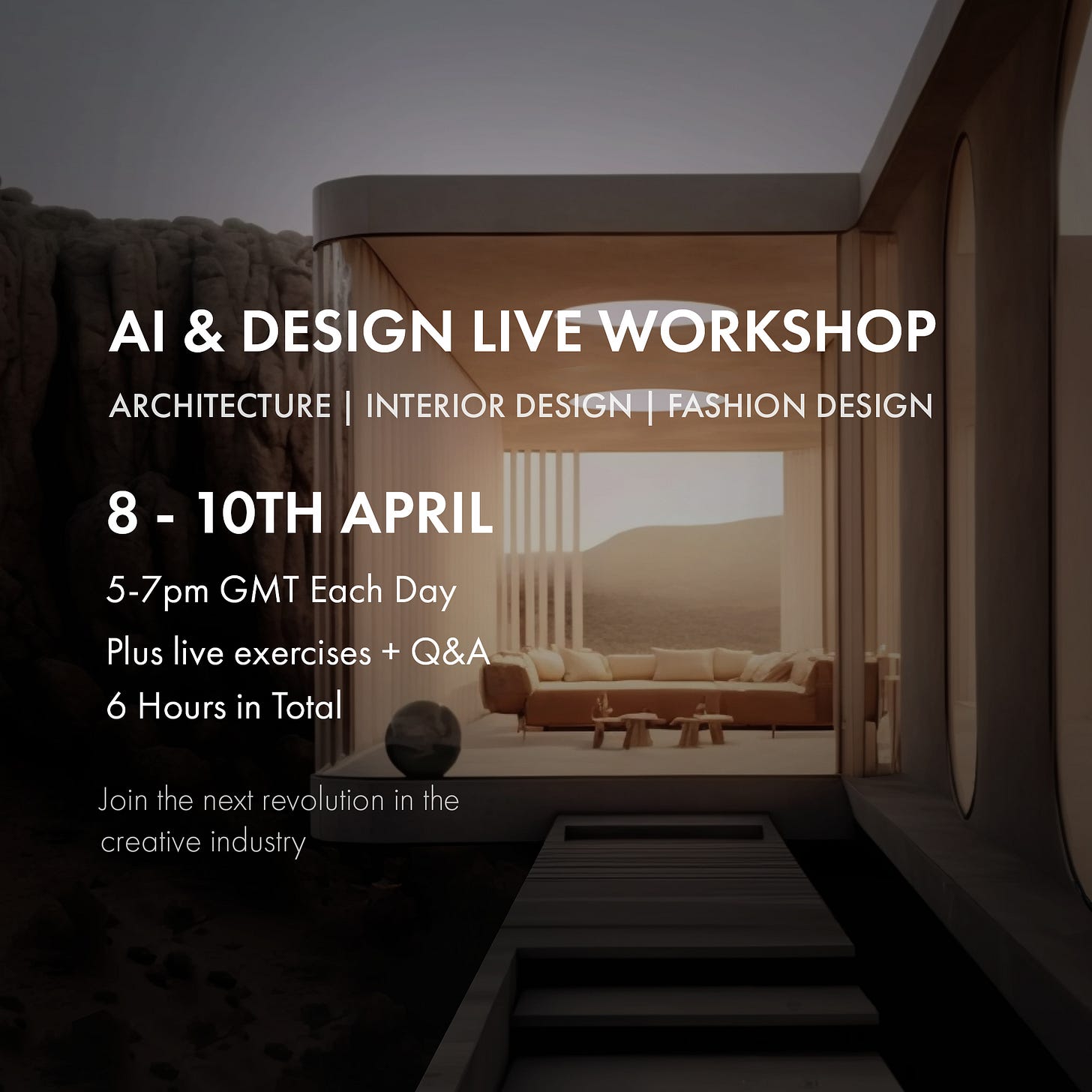Hey friends,
I'm writing this on my way to Milan, where I'm hoping to escape the crappy London weather while preparing invitations for AI Hub's private demo event, which will be happening next week. I'm excited to meet our wonderful and talented guests, who will be joining us from a variety of creative backgrounds.
For those who have recently subscribed to the newsletter and are unaware of what I am referring to, AI Hub is a startup that helps the creative community navigate AI technology's paradigm shift towards unparalleled creativity in the creative industry.
Last week, I had the opportunity to speak with Stephen Drew on his podcast Architecture Social about how architects can leverage the power of AI technology. We covered a lot of ground on the podcast, so if you haven't already, I highly recommend watching it. As I was contemplating the points that we discussed on the pod, I thought it would be good to talk about one of the key questions that Stephen asked me about "How can architects start working with AI and integrate AI tools in their day-to-day workflow?".
I think that's a great question, and I get asked about it in various formats by architects and students, so I decided to make some simple bullet points here in the newsletter.
Understand the basics of generative AI
As a first step, we designers must understand how generative AI and machine learning programmes work. You don't have to become an AI scientist to understand how generative AI works, but even a basic understanding of the subject can help you communicate your ideas with the AI tools you'll be using.
Explore tools
After getting familiar with the basics of generative AI, it’s time to explore different tools that you can possibly use in your creative workflow:
Chat GPT: Is a powerful text-based AI chatbot that you can use in a variety if ways. The best use of Chat GPT in design is to use it to get help on defining the brief of the project, brainstorming ideas for designing particular themes and moods, asking it to suggest some influential figures in specific design style and industry and trying to use the references in your work.
Midjourney: Midjourney is a popular text-to-image and image-to-image tool that can be used to design. Midjourney is an excellent design tool because it provides a high level of control over the images, allowing them to be more detailed and specific. You can specify the details of your design to the algorithm using a variety of parameters and methods, resulting in more accurate results.
Stable Diffusion: Stable Diffusion is yet another text-to-image and image-to-image design tool; however, there is one significant difference between Midjourney and Stable Diffusion, and that is its open source programme. Having an open source programme means that the original programme can be modified to make specific changes. That is why a few good programmes, such as Control Net, leverage Stable's Diffusion model to provide nuanced flexibilities and features on top of Stable Diffusion's model.
Dall.E : This tool differs slightly in terms of features from both Midjourney and Stable Diffusion. It has fewer parameters and variables, but it has some interesting features like outpainting that none of the other tools has. To design outside the image borders, use the outpainting tool. That is, you can use this feature to imagine the remainder of an image and extend the canvas.
Start Experimenting
After you've completed the preceding steps, it's time to get your hands dirty with at least one of these tools. My recommendation is to start with Midjourney since you don’t need any advanced knowledge of using the programme for a very basic level. However, it would help if you did not stop at the beginner level and looked for tips and tricks to help you become an AI designer.
There is so much information that you can find on the websites like youtube and there are plenty of Midjourney tutorials to help you progress. However, if you want to receive all of the information you need to know about using tools like Midjourney, you can join my workshop, where I will be teaching absolutely everything I learned from working on real-world projects with clients using AI in a structured format.
Make sure to use the code 30NEWSLETTER to receive 30% off of the workshop price as a valued reader of my newsletter.
I hope this week’s blog has helped you to start taking baby steps towards learning to integrate AI into your design processes.
I will be more than happy to answer any questions about AI or the workshop so if you want to ask me anything please drop me a line to hello@amirhosseinnoori.com
Hope you enjoy the rest of your weekend and I can’t wait to write to you next week!
Amir xx
❤️My Favourite Things
🤠Workshop - AI & Design Live Workshop -Join the next revolution in the creative industry and learn how to integrate AI into your day-to-day design processes. Use the code 30NEWSLETTER to receive a 30% discount.
🎙️Podcast - How to harness the power of AI in architecture -An episode from Stephen Drew’s Architecture Social Podcast where we sat for an hour and discussed how AI could change the architecture industry.
📍Things to do - Thin Air - Thin Air is making its way into The Beams over in the Royal Docks this month, just across the river from Greenwich. And The Beams – if you don’t know it – is all-caps, underlined, italicised, HUGE . It’s 55,000 square feet of industrial space, so quite understandably, the first art exhibition to go on show there is going to make use of that scale in interesting ways. Interesting ways like algorithmically generated images, massive volumetric laser arrays, and large-scale installations that sync with booming sound & music.

